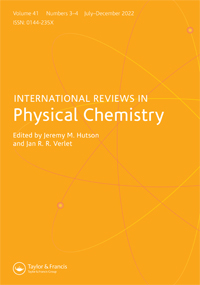选定尺寸气相团簇的辐射冷却
IF 2.5
2区 化学
Q3 CHEMISTRY, PHYSICAL
引用次数: 12
摘要
热填充激发态的辐射在近40年前就被预测出来,最近被认为是自由分子和团簇中的重要冷却机制。目前已经在分子束和离子存储装置中的无机簇和碳基分子中观察到这种现象。实验已经证明,许多这样的系统以接近微秒时间尺度的速率辐射,并且通常明显依赖于系统中原子的精确数量。辐射对单分子衰变和热电子发射都起着很强的稳定作用。在天体物理学的背景下,辐射冷却提供了一种在恒星形成过程中耗散内能的机制,并在星周介质中选择性地稳定分子。主动辐射冷却通道对纳米颗粒生产的影响同样有利于非平衡形成过程中特殊尺寸的纳米颗粒。在这篇综述中,介绍了簇的辐射冷却,并举例说明了在小碳、金属和半导体簇以及多环芳烃分子上进行的实验。讨论了所使用的实验和理论技术,以及辐射冷却对团簇大小稳定模式的影响。本文章由计算机程序翻译,如有差异,请以英文原文为准。
Radiative cooling of size-selected gas phase clusters
Predicted almost forty years ago, the radiation from thermally populated excited electronic states has recently been recognised as an important cooling mechanism in free molecules and clusters. It has presently been observed from both inorganic clusters and carbon-based molecules in molecular beams and ion storage devices. Experiments have demonstrated that many of these systems radiate at rates approaching microsecond time scales, and often with a distinct dependence on the precise number of atoms in the system. The radiation acts as a strongly stabilising factor against both unimolecular decay and thermal electron emission. In astrophysical context, radiative cooling provides a mechanism to dissipate internal energy in star-forming processes, and stabilises molecules selectively in the circumstellar medium. The consequences of an active radiative cooling channel for nanoparticle production will likewise favour special sizes in non-equilibrium formation processes. In this review, the radiative cooling of clusters is presented and illustrated with examples of experiments performed on small carbon, metal, and semiconductor clusters, and on PAH molecules. The experimental and theoretical techniques used are discussed, together with the consequences of radiative cooling on size-to-size stability patterns of clusters.
求助全文
通过发布文献求助,成功后即可免费获取论文全文。
去求助
来源期刊
CiteScore
14.20
自引率
1.60%
发文量
5
审稿时长
1 months
期刊介绍:
International Reviews in Physical Chemistry publishes review articles describing frontier research areas in physical chemistry. Internationally renowned scientists describe their own research in the wider context of the field. The articles are of interest not only to specialists but also to those wishing to read general and authoritative accounts of recent developments in physical chemistry, chemical physics and theoretical chemistry. The journal appeals to research workers, lecturers and research students alike.

 求助内容:
求助内容: 应助结果提醒方式:
应助结果提醒方式:


